Watering Vegetables - the Basics
If you are in the California Bay Area, watering vegetables is necessary during the summer, much of the spring and fall, and sometimes even in the winter. Because California has a Mediterranean climate, it receives most of its rain during the winter, and little in the warmer growing seasons. Vegetables need water while they are growing, so it’s up to the gardener to supply it. This post will discuss the basics of watering vegetables in Alameda County and provide some “beyond basics” tips.
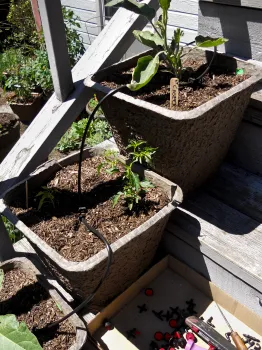
Watering Vegetables - How Much and How Often?
How much should you water your vegetable garden? The irritating (but true) answer to that question is that it depends on many things:
Season and Weather:
The warmer temperatures and longer, sunnier days of summer, together with the lack of rain make careful vegetable watering mandatory in the summer in our areas. The warmer the temperature and the longer the day, the more water is needed. Plants in full sun require more water than plants receiving some shade throughout the day. An increase in wind also calls for additional water.
Soil type:
Sandy soils drain more quickly, so they should receive smaller, more frequent waterings. Clay soils should be watered deeply and less frequently because this soil type holds onto moisture longer. Clay soil is quite common in the San Francisco Bay Area. Some areas near the Bayshore have sandy soil. Here are some handy tips on evaluating your soil type.
Plant age and growth stage:
Seeds and seedlings need frequent, consistent moisture to get started. Seed beds should stay moist on and under the surface until the seeds have sprouted. Seedlings also need dampness on the surface until their roots grow deep enough to reach the moister soil below. Many vegetables, such as beans, cucumbers, squash, tomatoes, peppers and eggplant, need water most when flowering and setting fruit.
Which plant:
Even among vegetables, some plant species simply require more or less water than others. Corn and most beans require the greatest water use of commonly-planted summer vegetables. Lettuce and other cool-season plants (other greens, broccoli, etc.) also require a good deal of consistent moisture when grown in the summer. Tomatoes and other deep-rooted plants tend to require less irrigation.
Rules of thumb:
Generally, you will need to irrigate your vegetable garden 1 to 3 times per week in the summer. In the milder-weather parts of our Bay Area that are west of the East Bay Hills, the quantity of water used each time will generally be less than needed in the much warmer Tri-Valley area. Generally, once vegetables are growing well, fewer deep waterings are better than more smaller waterings, but if you have sandy soil, start with more times per week with less water each time to avoid the water draining too quickly.
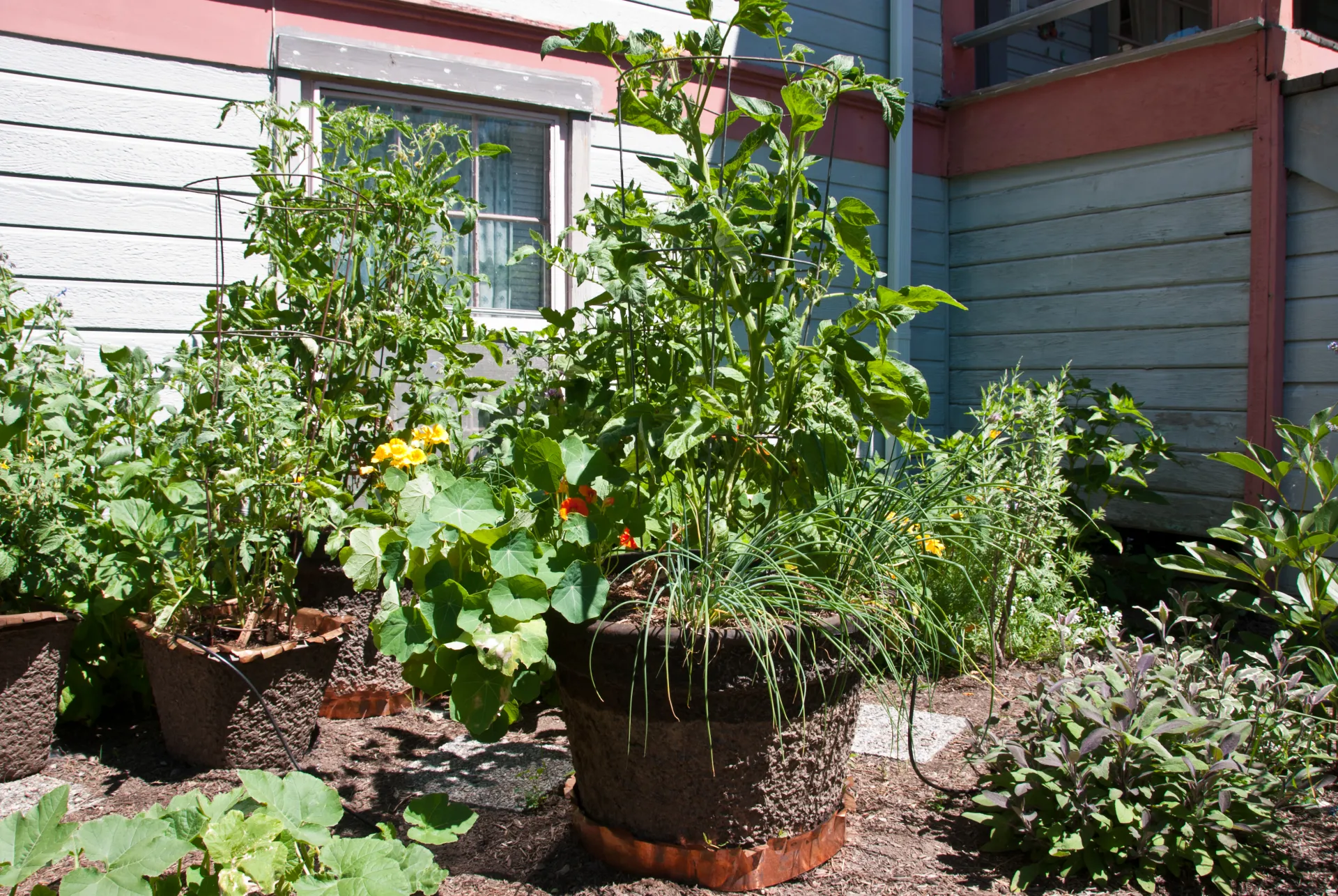
Putting this all together:
Vegetables do best when the soil around their roots is evenly moist but not wet. Determining how much and how often to water your vegetables to achieve this goal requires a bit of experimentation.
- If using a drip system or soaker hose, a good place to start is 2 - 3 times per week, 10-15 minutes each time
- When watering by hose or watering can, a general rule of thumb is that in warm summer weather vegetables need .68 gallons of water per square foot of ground each week, divided over the number of times you water each week.
- In between waterings for established plants, check the soil moisture around the plant root zone by using a finger or a moisture probe to sense the moisture about 2 inches down. If in the middle of the watering interval, the soil is dried on the top but feels moist about 2 inches down then the watering time is right.
- If the soil looks like it is still moist on top or feels wet 2 inches down, then you can increase the time between waterings or decrease the amount of water.
- If the soil feels dry a ½ to 1 finger length down then the amount of water or the number of waterings should be increased.
- Once you’ve found the sweet spot, congratulate yourself! You will still need to adjust to provide more water or more frequent waterings as the temperature gets warmer and perhaps as the plant grows larger. If we get a heat wave, or a patch of windier weather, more water is likely to be needed quickly, so stay alert!
- Containers can dry out fast, so monitor more frequently to avoid an unexpectedly parched plant. Fabric grow bags can dry out even faster, because water evaporates through the fabric sides.
- For all vegetable gardeners, it's important to remember that more water is not necessarily better. Overwatering is a frequent cause of plant disease and even death, since too much water can limit oxygen in the soil’s pore spaces and drown the roots.
To make the most of your irrigation water, check out these 8 Water-Wise Tips You Can Start Today.
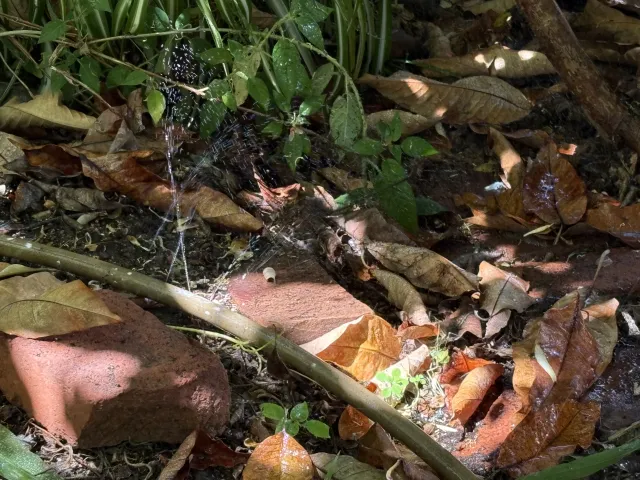
Mechanics of watering vegetables
Compare the Methods.
The most common methods for watering your vegetable garden are: watering can or hose, drip system, or soaker hose. Sprinklers are less used in vegetable gardens because when the plant leaves are wetted, the plant becomes more vulnerable to some fungal diseases.
Drip irrigation uses interconnected tubing and emitters to slowly release water onto the soil surface at a consistent rate. It delivers water only where needed, allows for maximum water uptake by the roots, reduces water lost by runoff, and limits the growth of weeds.
While the soaker hose has some of the same advantages of a drip system, it lacks the efficiency and precision of drip irrigation. Soaker hoses work by attaching to a spigot, being placed horizontally across the ground, and releasing consistent and evenly distributed water across the entire length of the hose. Soaker hoses generally apply water in straight lines. A lightweight alternative of a soaker hose common in larger growing operations is drip tape.
Both soaker hoses and drip irrigation systems can clog from soil and water particles, and can also get damaged or worn out by the environmental conditions they are exposed to over time.
Watering Methods - Pros and Cons | ||
Method | Pros | Cons |
Watering can or garden hose
|
|
|
Drip system
|
|
|
Soaker hoses/drip tape
|
|
|
Timers are highly recommended for drip and soaker hose systems. Timers minimize your risk of missing a watering, and allow you to go away for a few days without a garden-sitter. You’ll still want to check the garden frequently to make sure you aren’t watering too much, that nothing has clogged the system and that all parts of the garden are getting the water they need.
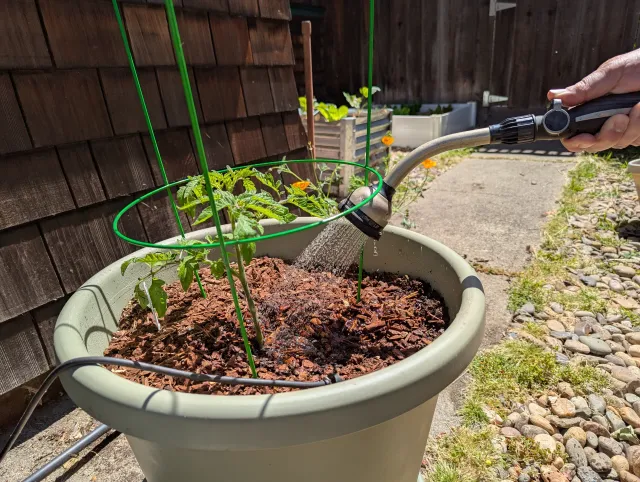
Mulch, the gardener’s friend.
Adding 3 to 4 inches of organic mulch over the surface of the soil is a very easy way of making the most of the water you put into your vegetable garden. Mulching can decrease the amount of water lost due to evaporation from the soil by 70% or more. Mulching also helps prevent weeds from germinating, reduces crusting and cracking of the soil surface, and maintains cooler soil temperatures. Organic mulch ( compost, bark, arborist chips, straw, DRY grass clippings) also improves soil structure it decomposes. Pretty much everything you would want to know about mulch.
Mulch and Compost - what’s the difference?
Mulch is a material that lays on top of the soil, protecting it as described above. Soil amendments are materials that are mixed into the top few inches of the soil, that improve the structure of the soil and that may add nutrients. Compost is the product of the controlled biological decomposition of organic material In home gardening, the material to be decomposed is typically yard and kitchen waste. Compost can be either a mulch or a soil amendment, depending on how you use it. Fine, nutrient dense compost, though, may not function well to suppress weeds.
Compost can be made at home, if you have the space. Compost can also be obtained for free from many municipalities, or purchased from nurseries or garden supply stores.
Tips on applying mulch:
- Ensure soil is thoroughly irrigated and moist before mulching.
- Keep mulch several inches away from plant stems to maintain good air circulation and reduce the risk of fungal disease to plants.
A Caution:
One drawback is that some studies show that the use of organic mulch increases risk of flammability in residential landscapes. Some local rules prohibit the use of organic mulches in portions of high fire areas. Check your local rules and consider whether that may be an issue for you.
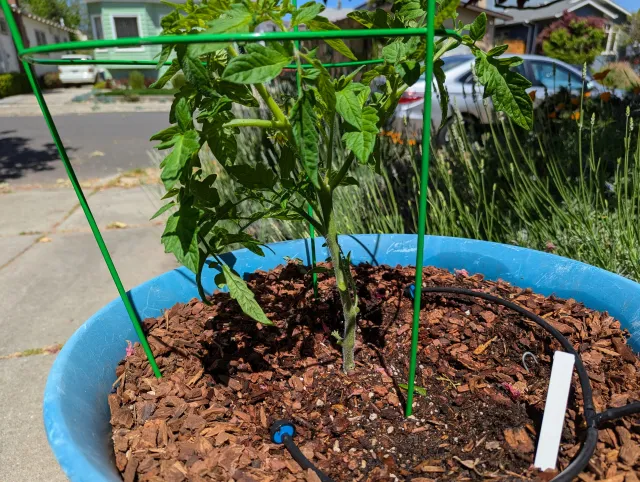
Tips for watering vegetables
- At the beginning of each growing season, check your irrigation system. Make sure that everything that should be getting watered is, and there are no puddles or pooling. During the growing season, walk your garden frequently checking for plants that might be getting too much or too little water. Parts break and drippers get knocked off from time to time.
- Before you start planting, be sure your garden bed is moist to at least 12 inches deep.
- Water before mid-morning to minimize evaporation.
- Always water plants before applying fertilizer.
- Containers can dry out fast, so monitor more frequently to avoid an unexpectedly parched plant.
- If you are using a watering can or hose, use a slow even spray to avoid washing the soil away. Stop or slow watering if the water runs off the soil surface, rather than sinking in.
- Remove weeds - they compete with your vegetables for water.
- Shallow rooted plants such as lettuce and other greens may require frequent shallow watering while plants with deeper roots, such as tomatoes, may be irrigated less often.
There’s a good bit to know about watering vegetables, but plants are adaptable and they want to grow. The key for the gardener is to pay attention to your plants and their soil and respond to what they need! Happy veggie growing!
References
Determining your soil type, from the UC Master Gardeners of Butte County
Mulches for Landscapes (opens a PDF) from Jim Downer, UCANR
Where to find compost
- Compost in a Hurry (opens a PDF) from Pamela M. Geisel and Carolyn L. Unrush, UCANR
- Get Free Compost from StopWaste
Tips on Conserving water:
- From the UC Master Gardeners of Butte County
- From the UC Master Gardeners of Alameda County
Checking your Irrigation System from the UC Master Gardeners of Alameda County
Want to learn more?
This blog post is brought to you by the Help Desk of the UC Master Gardeners of Alameda County. Subscribe to our blog!
Have a gardening question? We'll help.
Visit our Help Desk page to submit your question and see additional ways you can reach us.
